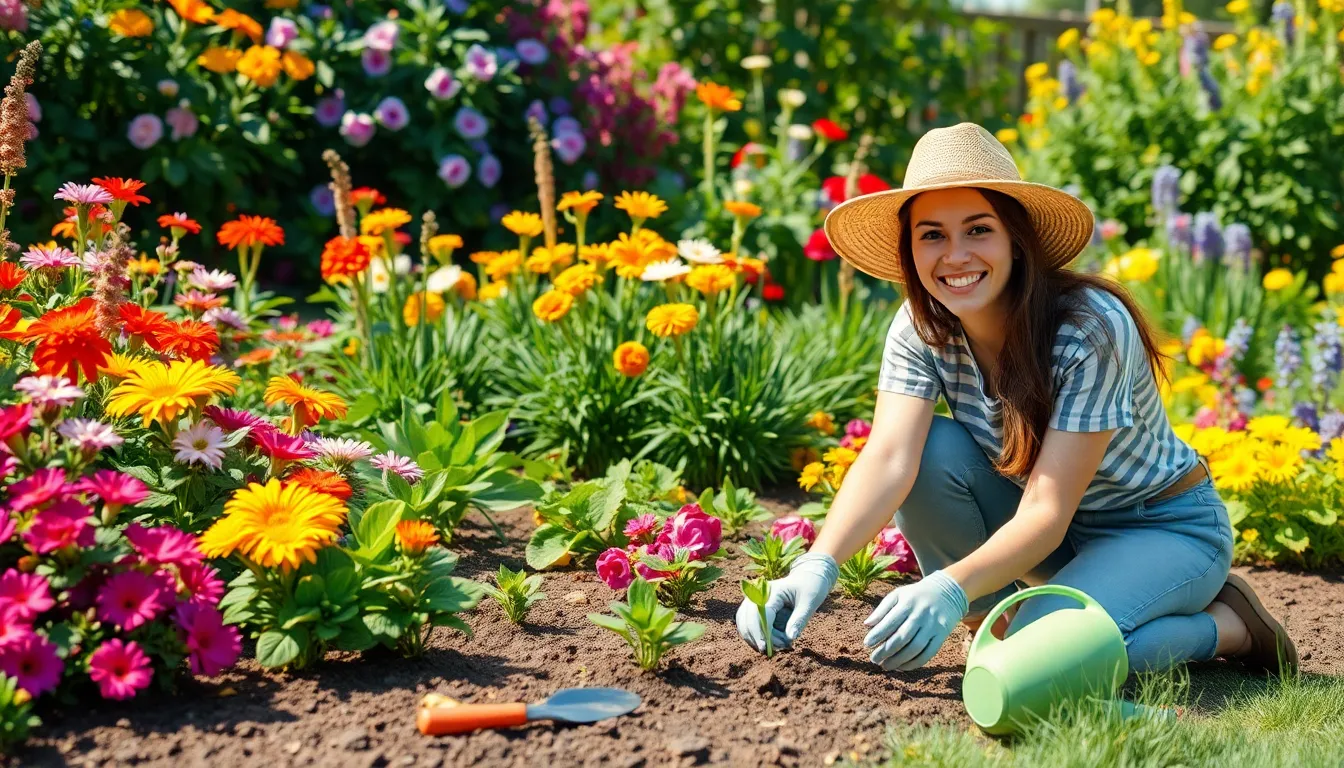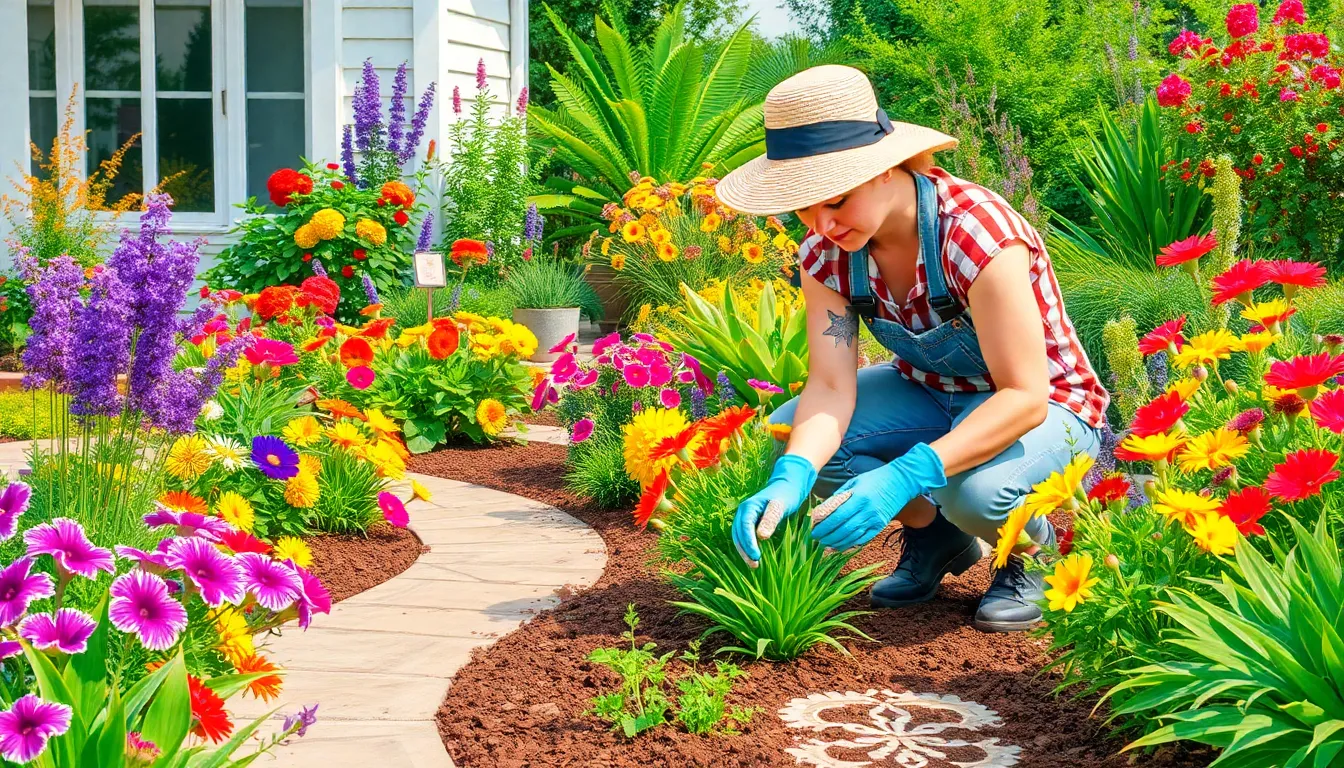Phone:
(701)814-6992
Physical address:
6296 Donnelly Plaza
Ratkeville, Bahamas.

Designing a garden can feel like trying to solve a Rubik’s Cube while blindfolded. With so many colors, shapes, and sizes to consider, it’s easy to get overwhelmed. But fear not! Creating a beautiful outdoor space is not only achievable but also a chance to unleash your inner landscape artist.
Understanding specific aspects of a garden space ensures effective design. Key considerations include sunlight exposure and soil conditions.
Sunlight defines plant growth in a garden. Observe how sunlight moves through your space throughout the day. Identify areas that receive full sun, partial shade, and full shade. Full sun zones receive at least six hours of direct sunlight. These areas work best for sun-loving plants like tomatoes and daisies. Plants in partial shade thrive with four to six hours of sunlight. Consider using ferns and hostas in these spots. Full shade areas, receiving less than four hours of sunlight, require shade-tolerant plants. Understanding these light conditions helps in selecting the right plants, optimizing growth and aesthetics.
Soil quality plays a vital role in garden health. Test soil pH levels to gauge acidity or alkalinity. Most plants thrive in a pH range of 6.0 to 7.0. Additionally, determine soil texture by examining its composition. Sandy soils offer good drainage, while clay soils retain moisture. High organic matter content improves soil structure and nutrient availability. Amending poor soils with compost or other organic materials promotes better plant health. Regular assessments of soil not only enhance plant growth but also improve the overall garden ecosystem.

Defining a garden style provides direction for the design process. Clarity in theme and plant selection creates a cohesive space that reflects personal taste.
Selecting a theme guides the overall aesthetic of the garden. Popular themes include modern, cottage, and tropical. Each theme features distinct elements that influence plant choices, layout, and decor. For instance, modern gardens often utilize clean lines and minimalistic plants, while cottage gardens embrace a more relaxed, informal style characterized by colorful blooms and diverse species. Identifying preferences helps streamline decisions, ensuring the garden mirrors individual creativity and lifestyle.
Choosing the right plants plays a crucial role in achieving desired outcomes. Factors like climate, soil type, and sunlight affect plant selection. Aiming for diversity maintains visual interest. Opt for native species as they typically require less maintenance, provide habitat for local wildlife, and thrive in the local environment. Incorporate a mix of annuals and perennials for year-round color and variety. Matching plant attributes with the garden’s thematic elements enhances harmony while promoting healthy growth.
A well-thought-out garden layout enhances the garden’s overall appeal and functionality. Thoughtful planning influences plant placement, creating a harmonious and efficient space.
Apply design principles like balance, unity, and rhythm to guide garden layout. Balance involves distributing visual weight evenly across the space, ensuring no area feels overcrowded. Unity creates a cohesive look through repeated colors or shapes. Focus on rhythm by arranging plants in a way that leads the eye throughout the garden, making the journey visually pleasing. Proportions dictate plant sizes and spacing, fostering a natural look, while alignment establishes paths or borders for structure. Integrating these principles adds depth and interest to the garden design.
Establish focal points to draw attention and create a sense of direction within the garden. Choose unique elements, such as striking sculptures or vibrant flowerbeds, to serve as visual anchors. Position focal points strategically so they complement the overall layout and are visible from different angles. They enrich the garden’s character while also providing context for surrounding vegetation. Utilize height, color, and texture variations in focal points to enhance visual appeal. Varying these elements contributes to a dynamic landscape, inviting exploration and engagement.
Selecting the right plants is crucial for creating a vibrant garden. Start by choosing plants well-suited to local climate conditions. Consider native species that thrive naturally in the area and require less maintenance. Explore a mix of annuals and perennials to ensure constant color throughout the seasons. Assess the garden’s sunlight exposure to determine whether to select sun-loving or shade-tolerant varieties. Grouping plants with similar water and sunlight needs simplifies care and enhances aesthetics.
Understanding plant maintenance ensures long-term success in the garden. Regularly check soil moisture to prevent overwatering or drought stress. Mulching around plants reduces weeds and retains soil moisture. Fertilize as necessary, focusing on the specific needs of each plant type. Regular deadheading promotes blooming and maintains a tidy appearance. Additionally, pruning strengthens plant health by removing dead or damaged growth. Scheduling seasonal check-ups allows for adjustments to care routines, contributing to a thriving garden space.
Effective watering solutions enhance garden health and sustainability. These systems contribute to growth while keeping maintenance manageable.
Various irrigation methods suit different garden designs. Drip irrigation delivers water directly to plant roots, minimizing evaporation. Soaker hoses provide slow, even watering for beds filled with vegetables or flowers. Sprinkler systems work well for covering larger areas, ensuring uniform distribution. Hand watering remains a viable option for small gardens, enabling gardeners to provide personalized attention. Each method has advantages that cater to specific plant needs and garden layouts.
Adequate drainage prevents waterlogging and promotes healthy root systems. Poor drainage can lead to soil saturation, harming plants and contributing to root rot. Incorporating raised beds enhances drainage, allowing excess water to escape while improving soil quality. Amending soil with organic matter increases its ability to drain and retain nutrients effectively. Additionally, installing drainage systems, such as French drains, directs excess water away from garden areas, maintaining an optimal environment for plant growth.
Designing a garden is a rewarding journey that allows creativity to flourish. By understanding the unique characteristics of the garden space and selecting the right plants, anyone can create a vibrant outdoor oasis.
Thoughtful planning and a clear theme guide the design process, ensuring a cohesive and inviting atmosphere. Incorporating diverse plant selections not only enhances visual appeal but also promotes a healthy ecosystem.
With proper maintenance and effective watering solutions, a garden can thrive year-round. Embracing these principles will lead to a beautiful and sustainable garden that reflects personal style and nurtures the environment.